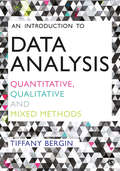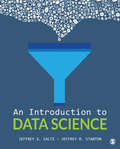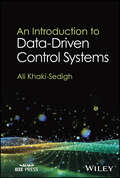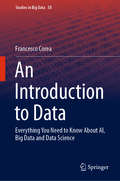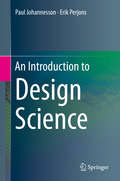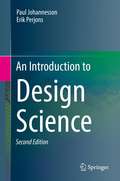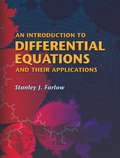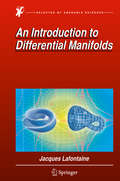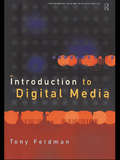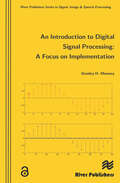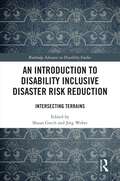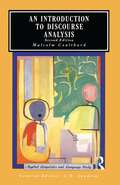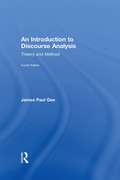- Table View
- List View
An Introduction to Data Analysis: Quantitative, Qualitative and Mixed Methods
by Tiffany BerginCovering the general process of data analysis to finding, collecting, organizing, and presenting data, this book offers a complete introduction to the fundamentals of data analysis. Using real-world case studies as illustrations, it helps readers understand theories behind and develop techniques for conducting quantitative, qualitative, and mixed methods data analysis. With an easy-to-follow organization and clear, jargon-free language, it helps readers not only become proficient data analysts, but also develop the critical thinking skills necessary to assess analyses presented by others in both academic research and the popular media. It includes advice on: - Data analysis frameworks - Validity and credibility of data - Sampling techniques - Data management - The big data phenomenon - Data visualisation - Effective data communication Whether you are new to data analysis or looking for a quick-reference guide to key principles of the process, this book will help you uncover nuances, complexities, patterns, and relationships among all types of data.
An Introduction to Data Analysis: Quantitative, Qualitative and Mixed Methods
by Tiffany BerginCovering the general process of data analysis to finding, collecting, organizing, and presenting data, this book offers a complete introduction to the fundamentals of data analysis. Using real-world case studies as illustrations, it helps readers understand theories behind and develop techniques for conducting quantitative, qualitative, and mixed methods data analysis. With an easy-to-follow organization and clear, jargon-free language, it helps readers not only become proficient data analysts, but also develop the critical thinking skills necessary to assess analyses presented by others in both academic research and the popular media. It includes advice on: - Data analysis frameworks - Validity and credibility of data - Sampling techniques - Data management - The big data phenomenon - Data visualisation - Effective data communication Whether you are new to data analysis or looking for a quick-reference guide to key principles of the process, this book will help you uncover nuances, complexities, patterns, and relationships among all types of data.
An Introduction to Data Science
by Jeffrey S. Saltz Jeffrey Morgan StantonAn Introduction to Data Science is an easy-to-read, gentle introduction for advanced undergraduate, certificate, and graduate students coming from a wide range of backgrounds into the world of data science. After introducing the basic concepts of data science, the book builds on these foundations to explain data science techniques using the R programming language and RStudio® from the ground up. Short chapters allow instructors to group concepts together for a semester course and provide students with manageable amounts of information for each concept. By taking students systematically through the R programming environment, the book takes the fear out of data science and familiarizes students with the environment so they can be successful when performing advanced functions. The authors cover statistics from a conceptual standpoint, focusing on how to use and interpret statistics, rather than the math behind the statistics. This text then demonstrates how to use data effectively and efficiently to construct models, predict outcomes, visualize data, and make decisions. Accompanying digital resources provide code and datasets for instructors and learners to perform a wide range of data science tasks.
An Introduction to Data Science
by Jeffrey S. Saltz Jeffrey Morgan StantonAn Introduction to Data Science is an easy-to-read, gentle introduction for advanced undergraduate, certificate, and graduate students coming from a wide range of backgrounds into the world of data science. After introducing the basic concepts of data science, the book builds on these foundations to explain data science techniques using the R programming language and RStudio® from the ground up. Short chapters allow instructors to group concepts together for a semester course and provide students with manageable amounts of information for each concept. By taking students systematically through the R programming environment, the book takes the fear out of data science and familiarizes students with the environment so they can be successful when performing advanced functions. The authors cover statistics from a conceptual standpoint, focusing on how to use and interpret statistics, rather than the math behind the statistics. This text then demonstrates how to use data effectively and efficiently to construct models, predict outcomes, visualize data, and make decisions. Accompanying digital resources provide code and datasets for instructors and learners to perform a wide range of data science tasks.
An Introduction to Data Science With Python
by Jeffrey S. Saltz Jeffrey Morgan StantonAn Introduction to Data Science with Python by Jeffrey S. Saltz and Jeffery M. Stanton provides readers who are new to Python and data science with a step-by-step walkthrough of the tools and techniques used to analyze data and generate predictive models. After introducing the basic concepts of data science, the book builds on these foundations to explain data science techniques using Python-based Jupyter Notebooks. The techniques include making tables and data frames, computing statistics, managing data, creating data visualizations, and building machine learning models. Each chapter breaks down the process into simple steps and components so students with no more than a high school algebra background will still find the concepts and code intelligible. Explanations are reinforced with linked practice questions throughout to check reader understanding. The book also covers advanced topics such as neural networks and deep learning, the basis of many recent and startling advances in machine learning and artificial intelligence. With their trademark humor and clear explanations, Saltz and Stanton provide a gentle introduction to this powerful data science tool. Included with this title: LMS Cartridge: Import this title’s instructor resources into your school’s learning management system (LMS) and save time. Don′t use an LMS? You can still access all of the same online resources for this title via the password-protected Instructor Resource Site.
An Introduction to Data Science With Python
by Jeffrey S. Saltz Jeffrey Morgan StantonAn Introduction to Data Science with Python by Jeffrey S. Saltz and Jeffery M. Stanton provides readers who are new to Python and data science with a step-by-step walkthrough of the tools and techniques used to analyze data and generate predictive models. After introducing the basic concepts of data science, the book builds on these foundations to explain data science techniques using Python-based Jupyter Notebooks. The techniques include making tables and data frames, computing statistics, managing data, creating data visualizations, and building machine learning models. Each chapter breaks down the process into simple steps and components so students with no more than a high school algebra background will still find the concepts and code intelligible. Explanations are reinforced with linked practice questions throughout to check reader understanding. The book also covers advanced topics such as neural networks and deep learning, the basis of many recent and startling advances in machine learning and artificial intelligence. With their trademark humor and clear explanations, Saltz and Stanton provide a gentle introduction to this powerful data science tool. Included with this title: LMS Cartridge: Import this title’s instructor resources into your school’s learning management system (LMS) and save time. Don′t use an LMS? You can still access all of the same online resources for this title via the password-protected Instructor Resource Site.
An Introduction to Data-Driven Control Systems
by Ali Khaki-SedighAn Introduction to Data-Driven Control Systems An introduction to the emerging dominant paradigm in control design Model-based approaches to control systems design have long dominated the control systems design methodologies. However, most models require substantial prior or assumed information regarding the plant’s structure and internal dynamics. The data-driven paradigm in control systems design, which has proliferated rapidly in recent decades, requires only observed input-output data from plants, making it more flexible and broadly applicable. An Introduction to Data-Driven Control Systems provides a foundational overview of data-driven control systems methodologies. It presents key concepts and theories in an accessible way, without the need for the complex mathematics typically associated with technical publications in the field, and raises the important issues involved in applying these approaches. The result is a highly readable introduction to what promises to become the dominant control systems design paradigm. Readers will also find: An overview of philosophical-historical issues accompanying the emergence of data-driven control systems Design analysis of several conventional data-driven control systems design methodologies Algorithms and simulation results, with numerous examples, to facilitate the implementation of methods An Introduction to Data-Driven Control Systems is ideal for students and researchers in control theory or any other research area related to plant design and production.
An Introduction to Data: Everything You Need to Know About AI, Big Data and Data Science (Studies in Big Data #50)
by Francesco CoreaThis book reflects the author’s years of hands-on experience as an academic and practitioner. It is primarily intended for executives, managers and practitioners who want to redefine the way they think about artificial intelligence (AI) and other exponential technologies. Accordingly the book, which is structured as a collection of largely self-contained articles, includes both general strategic reflections and detailed sector-specific information. More concretely, it shares insights into what it means to work with AI and how to do it more efficiently; what it means to hire a data scientist and what new roles there are in the field; how to use AI in specific industries such as finance or insurance; how AI interacts with other technologies such as blockchain; and, in closing, a review of the use of AI in venture capital, as well as a snapshot of acceleration programs for AI companies.
An Introduction to Decision Theory
by Martin PetersonThis introduction to decision theory offers comprehensive and accessible discussions of decision-making under ignorance and risk, the foundations of utility theory, the debate over subjective and objective probability, Bayesianism, causal decision theory, game theory, and social choice theory. No mathematical skills are assumed, and all concepts and results are explained in non-technical and intuitive as well as more formal ways. There are over 100 exercises with solutions, and a glossary of key terms and concepts. An emphasis on foundational aspects of normative decision theory (rather than descriptive decision theory) makes the book particularly useful for philosophy students, but it will appeal to readers in a range of disciplines including economics, psychology, political science and computer science.
An Introduction to Decision Theory
by Martin PetersonThis introduction to decision theory offers comprehensive and accessible discussions of decision-making under ignorance and risk, the foundations of utility theory, the debate over subjective and objective probability, Bayesianism, causal decision theory, game theory, and social choice theory. No mathematical skills are assumed, and all concepts and results are explained in non-technical and intuitive as well as more formal ways. There are over 100 exercises with solutions, and a glossary of key terms and concepts. An emphasis on foundational aspects of normative decision theory (rather than descriptive decision theory) makes the book particularly useful for philosophy students, but it will appeal to readers in a range of disciplines including economics, psychology, political science and computer science.
An Introduction to Description Logic
by Franz Baader Ian Horrocks Carsten Lutz Uli SattlerDescription logics (DLs) have a long tradition in computer science and knowledge representation, being designed so that domain knowledge can be described and so that computers can reason about this knowledge. DLs have recently gained increased importance since they form the logical basis of widely used ontology languages, in particular the web ontology language OWL. Written by four renowned experts, this is the first textbook on description logics. It is suitable for self-study by graduates and as the basis for a university course. Starting from a basic DL, the book introduces the reader to their syntax, semantics, reasoning problems and model theory and discusses the computational complexity of these reasoning problems and algorithms to solve them. It then explores a variety of reasoning techniques, knowledge-based applications and tools and it describes the relationship between DLs and OWL.
An Introduction to Design Arguments
by Benjamin C. JantzenThe history of design arguments stretches back to before Aquinas, who claimed that things which lack intelligence nevertheless act for an end to achieve the best result. Although science has advanced to discredit this claim, it remains true that many biological systems display remarkable adaptations of means to ends. Versions of design arguments have persisted over the centuries and have culminated in theories that propose an intelligent designer of the universe. This volume is the only comprehensive survey of 2,000 years of debate, drawing on both historical and modern literature to identify, clarify, and assess critically the many forms of design argument for the existence of God. It provides a neutral, informative account of the topic from antiquity to Darwin, and includes concise primers on probability and cosmology. It will be of great value to upper-level undergraduates and graduates in philosophy of religion, theology, and philosophy of science.
An Introduction to Design Science
by Paul Johannesson Erik PerjonsThis book is an introductory text on design science, intended to support both graduate students and researchers in structuring, undertaking and presenting design science work. It builds on established design science methods as well as recent work on presenting design science studies and ethical principles for design science, and also offers novel instruments for visualizing the results, both in the form of process diagrams and through a canvas format. While the book does not presume any prior knowledge of design science, it provides readers with a thorough understanding of the subject and enables them to delve into much deeper detail, thanks to extensive sections on further reading. Design science in information systems and technology aims to create novel artifacts in the form of models, methods, and systems that support people in developing, using and maintaining IT solutions. This work focuses on design science as applied to information systems and technology, but it also includes examples from, and perspectives of, other fields of human practice. Chapter 1 provides an overview of design science and outlines its ties with empirical research. Chapter 2 discusses the various types and forms of knowledge that can be used and produced by design science research, while Chapter 3 presents a brief overview of common empirical research strategies and methods. Chapter 4 introduces a methodological framework for supporting researchers in doing design science research as well as in presenting their results. This framework includes five core activities, which are described in detail in Chapters 5 to 9. Chapter 10 discusses how to communicate design science results, while Chapter 11 compares the proposed methodological framework with methods for systems development and shows how they can be combined. Chapter 12 discusses how design science relates to research paradigms, in particular to positivism and interpretivism. Lastly, Chapter 13 discusses ethical issues and principles for design science research.
An Introduction to Design Science
by Paul Johannesson Erik PerjonsThis book is an introductory text on design science, intended to support both graduate students and researchers in structuring, undertaking and presenting design science work. It builds on established design science methods as well as recent work on presenting design science studies and ethical principles for design science, and also offers novel instruments for visualizing the results, both in the form of process diagrams and through a canvas format. While the book does not presume any prior knowledge of design science, it provides readers with a thorough understanding of the subject and enables them to delve into much deeper detail, thanks to extensive sections on further reading. Design science in information systems and technology aims to create novel artifacts in the form of models, methods, and systems that support people in developing, using and maintaining IT solutions. This work focuses on design science as applied to information systems and technology, but it also includes examples from, and perspectives of, other fields of human practice. Chapter 1 provides an overview of design science and outlines its ties with empirical research. Chapter 2 discusses the various types and forms of knowledge that can be used and produced by design science research, while Chapter 3 presents a brief overview of common empirical research strategies and methods. Chapter 4 introduces a methodological framework for supporting researchers in doing design science research as well as in presenting their results. This framework includes five core activities, which are described in detail in Chapters 5 to 9. Chapter 10 discusses how to communicate design science results, while Chapter 11 compares the proposed methodological framework with methods for systems development and shows how they can be combined. Chapter 12 discusses how design science relates to research paradigms, in particular to positivism and interpretivism, and Chapter 13 discusses ethical issues and principles for design science research. The new Chapter 14 showcases a study on digital health consultations and illustrates the whole process in one comprehensive example. Also added to this 2nd edition are a number of sections on practical guidelines for carrying out basic design science tasks, a discussion on design thinking and its relationship to design science, and the description of artefact classifications. Eventually, both the references in each chapter and the companion web site were updated to reflect recent findings.
An Introduction to Design and Culture: 1900 to the Present
by Penny SparkeThis third edition of An Introduction to Design and Culture has been revised and updated throughout to include issues of globalization, sustainability and digital/interactive design. New for this edition is a chapter which covers key changes in design culture. Design culture has changed dramatically in the 21st century, the designer-hero is now much less in evidence and design has become much more interdisciplinary. Drawing on a wealth of mass-produced artefacts, images and environments including sewing machines, cars, televisions, clothes, electronic and branded goods and exhibitions, author Penny Sparke shows how design has helped to shape and reflect our social and cultural development. This introduction to the development of modern (and postmodern) design is ideal for undergraduate students.
An Introduction to Design and Culture: 1900 to the Present
by Penny SparkeAn Introduction to Design and Culture provides a comprehensive guide to the changing relationships between design and culture from 1900 to the present day with an emphasis on five main themes: Design and consumption Design and technology The design profession Design theory Design and identities This fourth edition extends the traditional definition of design as covering product design, furniture design, interior design, fashion design and graphic design to embrace its more recent manifestations, which include service design, user-interface design, co-design, and sustainable design, among others. It also discusses the relationship between design and the new media and the effect of globalisation on design. Taking a broadly chronological approach, Professor Sparke employs historical methods to show how these themes developed through the twentieth century and into the twenty-first century and played a role within modernism, postmodernism and beyond. Over a hundred illustrations are used throughout to demonstrate the breadth of design and examples – among them design in Modern China, the work of Apple Computers Ltd., and design thinking – are used to elaborate key ideas. The new edition remains essential reading for undergraduate and postgraduate students of design studies, cultural studies and visual arts.
An Introduction to Differential Equations and Their Applications
by Stanley J. FarlowIntended for use in a beginning one-semester course in differential equations, this text is designed for students of pure and applied mathematics with a working knowledge of algebra, trigonometry, and elementary calculus. Its mathematical rigor is balanced by complete but simple explanations that appeal to readers' physical and geometric intuition.Starting with an introduction to differential equations, the text proceeds to examinations of first- and second-order differential equations, series solutions, the Laplace transform, systems of differential equations, difference equations, nonlinear differential equations and chaos, and partial differential equations. Numerous figures, problems with solutions, and historical notes clarify the text.
An Introduction to Differential Geometry
by T. J. WillmoreA solid introduction to the methods of differential geometry and tensor calculus, this volume is suitable for advanced undergraduate and graduate students of mathematics, physics, and engineering. Rather than a comprehensive account, it offers an introduction to the essential ideas and methods of differential geometry.Part 1 begins by employing vector methods to explore the classical theory of curves and surfaces. An introduction to the differential geometry of surfaces in the large provides students with ideas and techniques involved in global research. Part 2 introduces the concept of a tensor, first in algebra, then in calculus. It covers the basic theory of the absolute calculus and the fundamentals of Riemannian geometry. Worked examples and exercises appear throughout the text.
An Introduction to Differential Manifolds
by Jacques LafontaineThis book is an introduction to differential manifolds. It gives solid preliminaries for more advanced topics: Riemannian manifolds, differential topology, Lie theory. It presupposes little background: the reader is only expected to master basic differential calculus, and a little point-set topology. The book covers the main topics of differential geometry: manifolds, tangent space, vector fields, differential forms, Lie groups, and a few more sophisticated topics such as de Rham cohomology, degree theory and the Gauss-Bonnet theorem for surfaces. Its ambition is to give solid foundations. In particular, the introduction of "abstract" notions such as manifolds or differential forms is motivated via questions and examples from mathematics or theoretical physics. More than 150 exercises, some of them easy and classical, some others more sophisticated, will help the beginner as well as the more expert reader. Solutions are provided for most of them. The book should be of interest to various readers: undergraduate and graduate students for a first contact to differential manifolds, mathematicians from other fields and physicists who wish to acquire some feeling about this beautiful theory. The original French text Introduction aux variétés différentielles has been a best-seller in its category in France for many years. Jacques Lafontaine was successively assistant Professor at Paris Diderot University and Professor at the University of Montpellier, where he is presently emeritus. His main research interests are Riemannian and pseudo-Riemannian geometry, including some aspects of mathematical relativity. Besides his personal research articles, he was involved in several textbooks and research monographs.
An Introduction to Digital Media
by Tony FeldmanIn this clear and highly accessible book, Tony Feldman provides an account of the evolution and application of digital media. Clarifying its underlying technologies, he identifies its immense commercial and human potential. Using as a starting point a simplification which considers new media in two distinct sectors; packaged 'off-line' media such as CD-ROMs; and the world of transmitted media which includes digital broadcasting and interactive online services, Feldman provides a comprehensive overview of the digital media landscape. Focusing on multimedia and the entertainment media he describes and analyses the spectacular rise of CD-based information and the equally revolutionary development of the Internet and online services. Set within a commercial context, readers can identify the potential to generate revenue and profit from the new media. An Introduction to Digital Media concludes with a strategic assessment of the implications of going digital for individuals, companies and corporations.
An Introduction to Digital Signal Processing
by Stanley MneneyAn Introduction to Digital Signal Processing aims at undergraduate students who have basic knowledge in C programming, Circuit Theory, Systems and Simulations, and Spectral Analysis. The book is focused on basic concepts of digital signal processing, MATLAB simulation and implementation on selected DSP hardware in which the candidate is introduced to the basic concepts first before embarking to the practical part which comes in the later chapters. Initially Digital Signal Processing evolved as a postgraduate course which slowly filtered into the undergraduate curriculum as a simplified version of the latter. The goal was to study DSP concepts and to provide a foundation for further research where new and more efficient concepts and algorithms can be developed. Though this was very useful it did not arm the student with all the necessary tools that many industries using DSP technology would require to develop applications. This book is an attempt to bridge the gap. It is focused on basic concepts of digital signal processing, MATLAB simulation and implementation on selected DSP hardware. The objective is to win the student to use a variety of development tools to develop applications. Contents• Introduction to Digital Signal processing.• The transform domain analysis: the Discrete-Time Fourier Transform• The transform domain analysis: the Discrete Fourier Transform• The transform domain analysis: the z-transform• Review of Analogue Filter• Digital filter design.• Digital Signal Processing Implementation Issues• Digital Signal Processing Hardware and Software• Examples of DSK Filter Implementation
An Introduction to Disability Inclusive Disaster Risk Reduction: Intersecting Terrains (Routledge Advances in Disability Studies)
by Shaun Grech Jörg WeberThis first of its kind volume introduces Disability Inclusive Disaster Risk Reduction (DIDRR) in unprecedented critical and interdisciplinary ways covering the complex conceptual, theoretical and practice terrain. Established and emerging scholars and practitioners introduce and probe key discourses, theory, policy and practice at the intersections of disability, disasters and disaster risk reduction, navigating compound and dynamic areas including climate change, governance, wars and conflict, forced migration, disability representation, geopolitics, gender and ethnicity. This edited book lays out and questions established policies, discourses and practices in mainstream areas including Disaster Risk Reduction, Disaster Risk Management and Humanitarian Action, opening an effective critical debate to understand, challenge and shift dominant paradigms. By developing new theory on DIDRR, it will serve as an important tool for academics, researchers and practitioners working in multiple fields including disability studies, disaster management, global health, humanitarian studies, international studies and geography among others.
An Introduction to Disability Studies
by David JohnstoneDisability studies has become a legitimate area of academic study. It is multi-disciplinary in its critique of the oppressions that have historically "dumped" disabled people on the margins of society. This fully revised and updated edition not only explains disability studies as an academic field of inquiry, it also explores many of the current issues affecting the lives and circumstances of disabled people. The book explores and analyzes "quality of life" factors in the lives of disabled people in relation to the professional development of undergraduates and examines the emergence of "rights" for disabled people in the local area, the UK and abroad. The author indicates the strengths and weaknesses of organizations "of" and "for" disabled people, and provides examples of individual and institutional oppressions against disabled people and "success stories," exploring how these have been overcome in education and employment. The book suggests how disabled and non-disabled people can collaborate in the development of inclusive communities and neighborhoods. The text is suitable for students taking courses in the areas of health, social care and allied services at NVQ, BTEC, Degree and PGCE level. The author encourages students to raise their own questions and develop their own forms of inquiry.
An Introduction to Discourse Analysis (Applied Linguistics and Language Study)
by Malcolm Coulthard C. N. CondlinThe central concern of this book is the analysis of verbal interaction or discourse. This first six chapters report and evaluate major theoretical advances in the description of discourse. The final chapters demonstrate how the findings of discourse analysis can be used to investigate second-language teaching and first-language acquisition and to analyse literary texts.
An Introduction to Discourse Analysis: Theory and Method
by James Paul GeeDiscourse analysis considers how language, both spoken and written, enacts social and cultural perspectives and identities. Assuming no prior knowledge of linguistics, An Introduction to Discourse Analysis examines the field and presents James Paul Gee's unique integrated approach which incorporates both a theory of language-in-use and a method of research. An Introduction to Discourse Analysis can be used as a stand-alone textbook or ideally used in conjunction with the practical companion title How to do Discourse Analysis: A Toolkit. Together they provide the complete resource for students studying discourse analysis. Updated throughout, the fourth edition of this seminal textbook also includes two new chapters: 'What is Discourse?' to further understanding of the topic, as well as a new concluding section. A new companion website www.routledge.com/cw/gee features a frequently asked questions section, additional tasks to support understanding, a glossary and free access to journal articles by James Paul Gee. Clearly structured and written in a highly accessible style, An Introduction to Discourse Analysis includes perspectives from a variety of approaches and disciplines, including applied linguistics, education, psychology, anthropology and communication to help students and scholars from a range of backgrounds to formulate their own views on discourse and engage in their own discourse analysis. This is an essential textbook for all advanced undergraduate and postgraduate students of discourse analysis.
